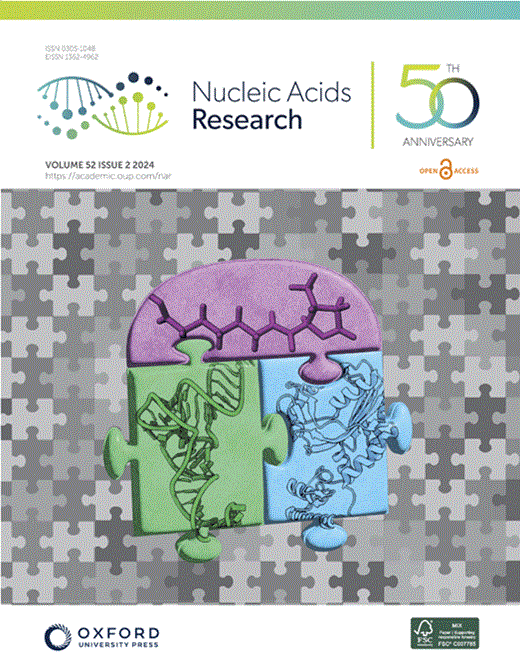CRISPR screening uncovers nucleolar RPL22 as a heterochromatin destabilizer and senescence driver.
IF 16.6
2区 生物学
Q1 BIOCHEMISTRY & MOLECULAR BIOLOGY
引用次数: 0
Abstract
Dysfunction of the ribosome manifests during cellular senescence and contributes to tissue aging, functional decline, and development of aging-related disorders in ways that have remained enigmatic. Here, we conducted a comprehensive CRISPR-based loss-of-function (LOF) screen of ribosome-associated genes (RAGs) in human mesenchymal progenitor cells (hMPCs). Through this approach, we identified ribosomal protein L22 (RPL22) as the foremost RAG whose deficiency mitigates the effects of cellular senescence. Consequently, absence of RPL22 delays hMPCs from becoming senescent, while an excess of RPL22 accelerates the senescence process. Mechanistically, we found in senescent hMPCs, RPL22 accumulates within the nucleolus. This accumulation triggers a cascade of events, including heterochromatin decompaction with concomitant degradation of key heterochromatin proteins, specifically heterochromatin protein 1γ (HP1γ) and heterochromatin protein KRAB-associated protein 1 (KAP1). Subsequently, RPL22-dependent breakdown of heterochromatin stimulates the transcription of ribosomal RNAs (rRNAs), triggering cellular senescence. In summary, our findings unveil a novel role for nucleolar RPL22 as a destabilizer of heterochromatin and a driver of cellular senescence, shedding new light on the intricate mechanisms underlying the aging process.CRISPR筛选发现核仁RPL22是一种异染色质不稳定因子和衰老驱动因子。
核糖体的功能障碍表现在细胞衰老过程中,并导致组织衰老、功能衰退和衰老相关疾病的发展,而这些问题至今仍是个谜。在这里,我们对人类间充质祖细胞(hMPCs)中的核糖体相关基因(RAGs)进行了全面的基于 CRISPR 的功能缺失(LOF)筛选。通过这种方法,我们发现核糖体蛋白 L22(RPL22)是最重要的 RAG,其缺失可减轻细胞衰老的影响。因此,缺乏 RPL22 会延缓 hMPC 的衰老,而 RPL22 过量则会加速衰老过程。从机理上讲,我们发现在衰老的 hMPC 中,RPL22 会在核仁内积聚。这种积累引发了一连串的事件,包括异染色质的分解以及关键异染色质蛋白的降解,特别是异染色质蛋白1γ(HP1γ)和异染色质蛋白KRAB相关蛋白1(KAP1)。随后,RPL22 依赖的异染色质分解刺激核糖体 RNA(rRNA)的转录,引发细胞衰老。总之,我们的研究结果揭示了核小体 RPL22 作为异染色质的不稳定因子和细胞衰老驱动因子的新作用,为研究衰老过程的复杂机制提供了新的视角。
本文章由计算机程序翻译,如有差异,请以英文原文为准。
求助全文
约1分钟内获得全文
求助全文
来源期刊

Nucleic Acids Research
生物-生化与分子生物学
CiteScore
27.10
自引率
4.70%
发文量
1057
审稿时长
2 months
期刊介绍:
Nucleic Acids Research (NAR) is a scientific journal that publishes research on various aspects of nucleic acids and proteins involved in nucleic acid metabolism and interactions. It covers areas such as chemistry and synthetic biology, computational biology, gene regulation, chromatin and epigenetics, genome integrity, repair and replication, genomics, molecular biology, nucleic acid enzymes, RNA, and structural biology. The journal also includes a Survey and Summary section for brief reviews. Additionally, each year, the first issue is dedicated to biological databases, and an issue in July focuses on web-based software resources for the biological community. Nucleic Acids Research is indexed by several services including Abstracts on Hygiene and Communicable Diseases, Animal Breeding Abstracts, Agricultural Engineering Abstracts, Agbiotech News and Information, BIOSIS Previews, CAB Abstracts, and EMBASE.
 求助内容:
求助内容: 应助结果提醒方式:
应助结果提醒方式:


